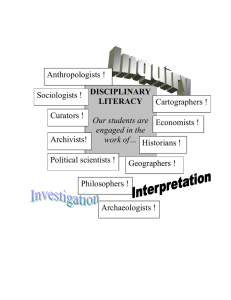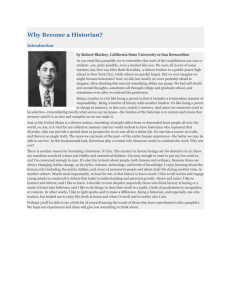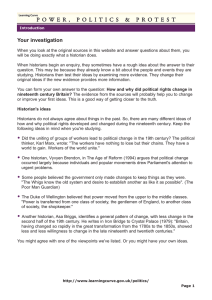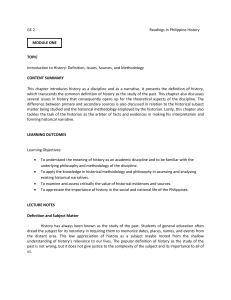Introduction to History: Definition, Sources, Methodology
advertisement
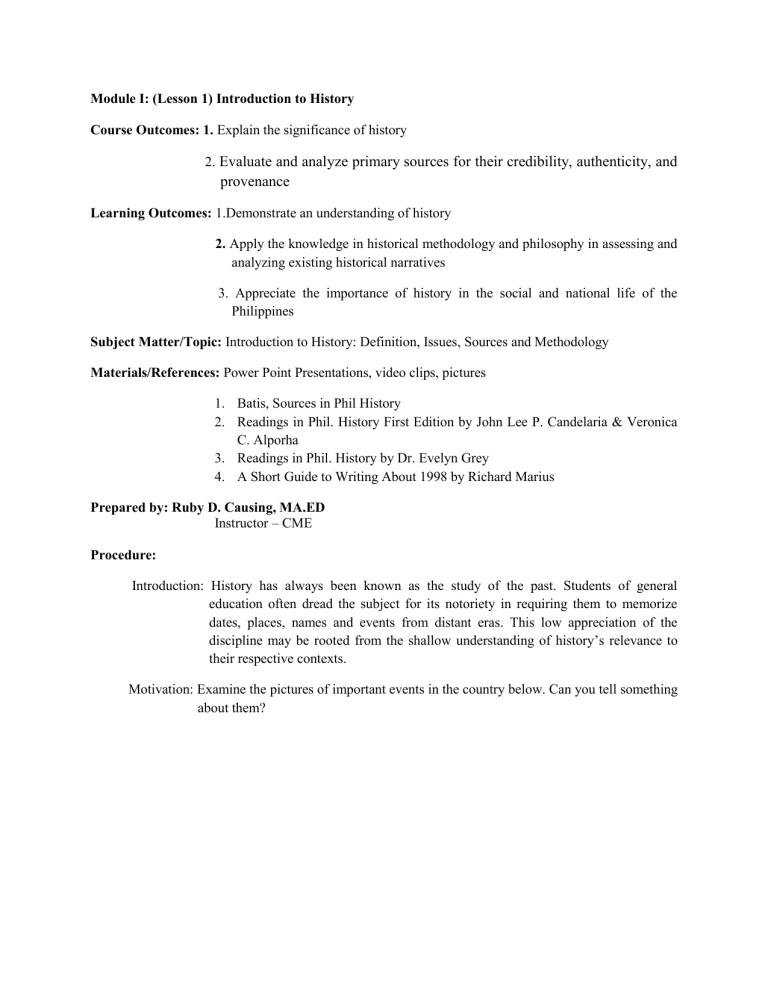
Module I: (Lesson 1) Introduction to History Course Outcomes: 1. Explain the significance of history 2. Evaluate and analyze primary sources for their credibility, authenticity, and provenance Learning Outcomes: 1.Demonstrate an understanding of history 2. Apply the knowledge in historical methodology and philosophy in assessing and analyzing existing historical narratives 3. Appreciate the importance of history in the social and national life of the Philippines Subject Matter/Topic: Introduction to History: Definition, Issues, Sources and Methodology Materials/References: Power Point Presentations, video clips, pictures 1. Batis, Sources in Phil History 2. Readings in Phil. History First Edition by John Lee P. Candelaria & Veronica C. Alporha 3. Readings in Phil. History by Dr. Evelyn Grey 4. A Short Guide to Writing About 1998 by Richard Marius Prepared by: Ruby D. Causing, MA.ED Instructor – CME Procedure: Introduction: History has always been known as the study of the past. Students of general education often dread the subject for its notoriety in requiring them to memorize dates, places, names and events from distant eras. This low appreciation of the discipline may be rooted from the shallow understanding of history’s relevance to their respective contexts. Motivation: Examine the pictures of important events in the country below. Can you tell something about them? Learning Activity: Choose a picture above and write something about the it. How did you know that information? How authentic are the information? What is the proof that this really exist? How is it relevant today? Discussion: History can be defined in several ways. It could be defined as a document record of man and his society. As a field of study, it is the study of man and his achievements from the beginning of written records to the present time (Gray 1956 in De Viana, 2015). It can be defined as everything that has happened or occurred from the beginning of the time to the last instance. As a record, it is a document history of man and his society. As literature, it is an effective presentation of the unfolding events. According to Abbot in De Viana (2015), the historian has the ability to depict the unraveling of fateful events and to priority the rise and deterioration of the character of events, ranking it with novels and epic poetry According to De Viana (2015), history as a record of events that shows the evolution of man and his society and from the age of barbarism to what he is today. In a simple manner, history is the study of the past, which such definition does not give justice to the complexity of the subject and its importance to human civilization For the students of history, it is the record of the past showing his development and improvement throughout the ages and how he met his various challenges through time. History is not merely a chronology but this should show a pattern on how man and his society has evolve from the primitive form to the present; showing his ability to cope with obstacles and challenges that he himself or nature has placed throughout his existence. However, students of general education often dread the subject for its notoriety in requiring them to memorize dates, places, names and events from distant eras. This low appreciation of the discipline may be rooted from the shallow understanding of history’s relevance to their lives and to their respective contexts. History was derived from the Greek word historia which means “knowledge acquired through inquiry or investigation”. History as a discipline existed for around 2400 years and its as old as mathematics and philosophy. This term was then adapted to classical Latin where it acquired a new definition. Historia became known as the account of the past of the person or of the group of people through written documents and historical evidences. It became the historian’s duty to write about the lives of important individuals like monarchs, heroes, saints and nobilities. History was also focused on writing about wars, revolutions and other important breakthroughs. Traditional historians lived in the mantra of “no document, no history”. It means that unless a written document can prove a certain historical event, then it can’t be considered as a historical fact. But as any other disciplines, history progressed and opened up to the possibility of valid historical sources, which were not limited to written documents, like government records, chronicler’s accounts, or personal letters. Giving premium to written documents essentially invalidates history of other civilizations that do not keep written records. Some were keener on passing their history by word of mouth. Others got their historical documents burned or destroyed in the events of war or colonization. Restricting historical evidence as exclusively written is also discrimination against other social classes who were not recorded in paper. Nobilities, monarchs, the elite and even the middle class would have their birth, education, marriage and death as matters of government and historical record. But what of peasant families or indigenous groups who were not given much thought about being registered to government records? Does the absence of written documents about them mean that they were people of no history or past? Did they even exist? This loophole was recognized by historians who started using other kinds of historical sources, which may not be written form but were just as valid. A few of these examples are oral traditions in the forms of epics and songs, artifacts, architecture and memory. History thus became more inclusive and started collaborating with other disciplines as its auxiliary disciplines. “Facts cannot speak for themselves”. It is the job of the historian to give meaning to these facts and organize them into timeline, establish causes and write history. He is a person of his own who is influenced by his own context, environment, ideology, education and influences, among others. In that sense, his interpretation of the historical fact is affected by his context and circumstances. His subjectivity will inevitably influence the process of his historical research; the methodology that he will use, the facts that he shall select and relevant, his interpretation and even the form of his writings. Thus, in one way or another, history is always subjective. If that is so, can history still be considered as an academic and scientific inquiry? Historical research requires rigor. Despite the fact that historians cannot ascertain absolute objectivity, the study of history remains scientific because of the rigor of resear4ch and methodology that the historians employ. Historical methodology comprises certain techniques and rules that historians follow in order to properly utilize sources and historical evidences in writing history. Sources of History Sources are very important in the study of history. Historical sources are the originators of information and data and the most important tools of historians. In general, historical sources can be classified between primary and secondary sources. The classification of the sources between these two categories depends on the historical subject being studied. Primary sources are those sources produced at the same time as the event, period or subject being studied. For example, if a historian wishes to study the Common wealth Constitution Convention of 1935, his primary sources can include the minutes of the convention, newspaper clippings, Philippine Commission reports of the U.S. Commissioners, records of the event. Eyewitnesses’ accounts of convention delegates and their memoirs can also be used as primary sources. The same goes with other subjects of the historical study. Archival documents, artifacts, memorabilia, letters, census, and government records, among others are the most common examples of primary sources. Formally, according to Torres (2018), there are 8 examples of primary sources: 1. Photographs that may reflect social conditions of historical realities and everyday life 2. Old sketches and drawings that may indicate the conditions of life of societies in the past 3. Old maps that may reveal how space and geography were used to emphasize trade routes, structural build up, etc. 4. Cartoons for political expressions or propaganda 5. Material evidence of the prehistoric past like cave, drawings, old syllabaries and ancient writings 6. Statistical tables, graphs and charts 7. Oral history or recordings by electronic means of accounts of eyewitnesses or participants; the recordings are then transcribed and used for research. 8. Published and unpublished primary documents, eyewitness accounts and other written sources On the other hand, secondary sources are those sources which were produced by an author who used primary sources to produce the material. In other words, secondary sources are historical sources, which studied a certain historical subject. For example, on the subject of the Philippine Revolution of 1896, students can read Teodoro Agoncillo’s Revolt of the Masses: The story of Bonifacio and the Katipunan published originally in 1956 which makes the Revolt of the Masses a secondary source. More than this, in writing the book, Agoncillo used primary sources with his research like documents of the Katipunan, interview with the veterans of the Revolution and correspondence between and among Katipuneros. Historians and students of history need to thoroughly scrutinize these historical sources to avoid deception and to come up with historical truth. The historian should be able to conduct an external and internal criticism of the source, especially primary sources which can age in centuries. External criticism is the practice of verifying the authenticity of the evidence by examining its physical characteristics; consistency with the historical characteristic of the time when it was produced; and the materials used for the evidence. Example the quality of paper, the type of ink and the language and words used in the material, among others. Internal criticism, on the other hand, is the examination of the truthfulness of the evidence. It looks at the content of the source and examines the circumstances of its production. It looks also at the truthfulness and factuality of the evidence by looking at the author of the source, its context, the agenda behind its creation, the knowledge which formed it and its independent purpose, among others. Validating historical sources is important because the use of unverified, falsified and untruthful historical sources can lead to equally false conclusions. Generalization: 1. History was derived from the Greek word historia which means “knowledge acquired through inquiry or investigation”. History as a discipline existed for around 2400 years and its as old as mathematics and philosophy. 2. History evolved, progressed and opened up to the possibility of valid historical sources. 3. History, like other academic discipline, does not claim to render absolute and exact judgment because as long as questions are continuously asked and as long as time unfolds, the study of history can never be completed. 4. Tasks of the historians in order to avoid deception on a certain document: a. to look at the available historical sources and select the most relevant and meaningful for history and for the subject matter that he is studying b. to organize the past that is being created so that so that it can offer lessons for nations, societies and civilization. c. to seek for the meaning of recovering the past to let the people see the continuing relevance of provenance, memory, remembering, and historical understanding for both the present and the future 5. There are 2 types of historical sources, Primary sources are those sources produced at the same time as the event, period or subject being studied and secondary sources are those sources which were produced by an author who used primary sources to produce the material. 6. The historian’s primary tool of understanding and interpreting the pas is primary source.
